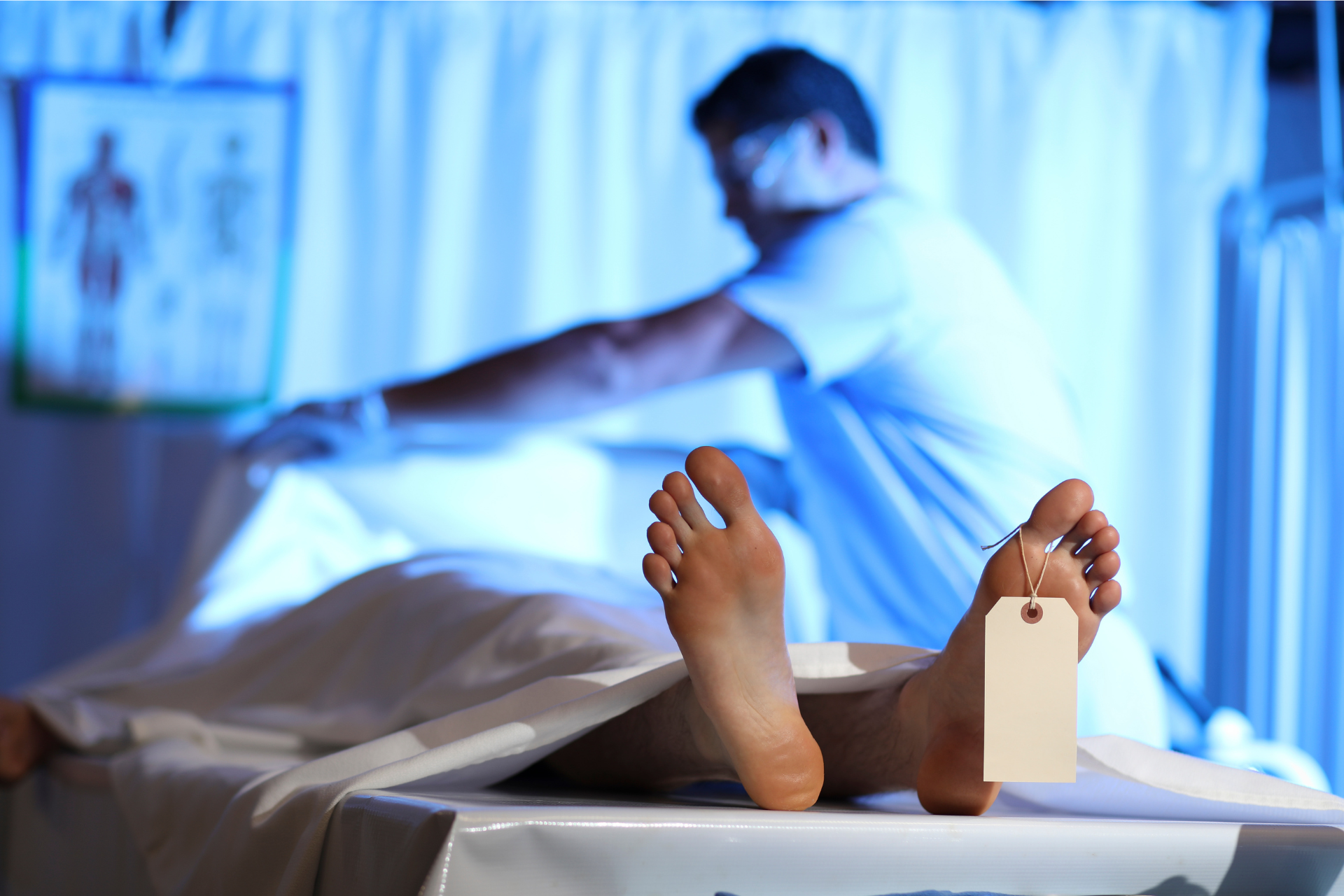Now Reading: Complication in Postmortem for Highly Decomposed Body
-
01
Complication in Postmortem for Highly Decomposed Body

Complication in Postmortem for Highly Decomposed Body
Autopsy (autos – self; opis – view) means ‘to see for oneself’. It defines as the detailed examination of both external surfaces and internal contents of a dead body after opening its cavities including further examination, such as histology, biochemistry & toxicology of collected material to determine the cause, mode and manner of death. Postmortem is the external examination of a dead body. A medico-legal autopsy (necropsy) or postmortem examination (necros – dead; opis – view; post – after; mortem – death). It is a scientific examination of a dead body carried out under the laws of the State for the protection of citizens and help in the identification and prosecution of guilty in case of unnatural deaths. (‘Necropsy’ is for non-human animals, which is common in veterinary medicine than human medicine. It is a standard method used by the veterinarians. It is mostly used like an autopsy to determine the cause of death).
In India, the postmortem and medico-legal examinations are carried out by the government medical officers who have undergone specialized training or experience in forensic medicine (forensic pathology). Generally, autopsy takes two to three hours to complete, except for unnecessary complications. Within 24 hours of death, it is best to perform.
Objectives of a medico-legal autopsy are:
- To determine the identity of the person.
- To determine:
- Cause of death, whether natural or unnatural (suicide, homicide or accident)
- Most important in homicide, to collect and document trace evidence, if any left by accused on the victim
- To find out the weapon, person or poison responsible for the death
- The voluntary activity possible after such trauma in fatal wounding case
- To determine the approximate time since death.
- In newly born infants case, to determine the question of live birth and viability of the child.
- In mutilated, fragmented or skeletal remains case, to determine if they are human; and if human, then probable cause of death and time since death.
- To restore the body to the best possible cosmetic appearance before it given to relatives.
In short postmortem examination helps in the criminal justice system to establish the corpus delicti, the modus operandi, and the sequence of events and to locate, collect and preserve clues to link the criminal with the crime, the crime scene and the victim.
Types of Autopsy:
- Medical/Clinical/Pathological/Hospital autopsy
- Anatomical autopsy
- Psychological autopsy
- Postmortem examination
- Virtual autopsy
- Medico-legal autopsy
Medical autopsy: It carried on a patient who dies in a hospital during treatment.
Anatomical autopsy: It is done to study the standard structure of the human body. It is done mostly on unclaimed dead bodies. Anatomist and medical students perform this.
Psychological autopsy: It is performed on alleged cases of suicide to understand the mental condition of the deceased at the time of death. It shows to understand the background of a person, his habits, mental status, personality, character, and relation to others. The source of collection of information is family members, friends, professional colleagues, teachers and physicians.
Postmortem examination: It is the external examination of surfaces of a corpse by inspection without giving incision for systematic examination. However, body fluids like blood, bile, urine may be collected.
Virtual autopsy: It is examination without compromising the integrity of the body, even without the collection of sample. Due to some reason or disease, the autopsy of the dead body is not possible then with the help of radiological examination, and we can detect the cause of death. (Methods- x-rays, ultrasounds, CT scan, MRI)
Medico-Legal autopsy: The examination of a dead body to rule out or establish wickedness in death. It performs in pursuance of law to ascertain the cause and manner of death and also to determine or rule the evil. The medico-legal autopsy was 1st time introduced in 1302 AD in Italy.
Physical Examination Involves
External Examination: An autopsy starts from the outside of the body and works inward. Therefore, an external examination is the first step. When a body received, firstly photographed by the investigator. Examiner looks at the outer appearance, including clothes and accessories. Then examiner notes the kinds of clothes and their position and the position on the body before they removed. Then the evidence such as a residue, flakes of paints or other material is collected from the external surface of the body for examination. Ultraviolet light is used to search for any evidence which is not easily visible to the naked eyes on the body surfaces. Sample of hair, nails are takes and radio graphed image is taken of the body. After collecting external evidence body is undressed and wounds are examined if present. The body is cleaned, weighed and measured in preparation for internal examination. General description of body like age, sex, race, hair color & length, eye color & other features (birthmarks, old scar tissues, moles, tattoos, etc.) is then made. A handheld voice recorder or a standard examination form is used to record this information.
Internal Examination: If the cause of death is not revealed by the naked eye, the medical officer take appropriate specimens for histology and culture. The major cavities of the body, viz. skull, thorax and abdomen, should me opened and examined. Incisions must be done to open these cavities.
Skin Incisions:
- The “I”-shaped incision, extends from the chin straight down to the symphysis pubis, passing either to the left or right of the umbilicus.
- “Y”-shaped incision begins at a point close to the acromial process, and the extension upto breast and across to the xiphoid process. And this incision is similarly made on the opposite side of the body. The incision is carried downwards to the symphysis from the xiphoid process.
- Modified “Y”-shaped incision: Incision made in the middle from the suprasternal notch to the symphysis pubis. It extends over the clavicle to its center on both sides and it passes upwards over the neck behind the ear.
For the removal of organs two techniques the Virchow technique (removing each organ individually) or the Rokitansky technique (all the organs are removed once) are used. The organs are weighed to detect the certain illness and blood samples are also taken for investigations. Tissue pieces of each organ are bieng examined under microscope. Contents of stomach are also examined as it indicates the time of death.
Complications during postmortem
Identity of the body is not possible in highly decomposed body due to decomposition of identifying features (face is decomposed or damaged by the animals, scars, clothes, tattoo marks, etc.). Sex cannot be determined as the lower limb or part of the body ii lost by the attacks of animals (e.g. rats, dogs, jackals, and birds, such as vulture) when body is exposed in an open. Once the skin is peeled off due to decomposition it very difficult to ascertain decomposition it is very difficult to ascertain the time since death and cause of death. Because injuries get obscured by enzymes and body fluid composition changes very much. In highly decomposed body, body fluids get decomposed. Sometimes DNA analysis is failed as proper bones are not present as it is dispersed by the animals. Sometimes it is difficult to extract DNA from bone marrow as insect larvae are present inside it. Proper intact bone marrow, if it broke then it is not helpful. If the body highly decomposed, the entomological study is difficult as the body tissue will decompose. If in a case trace amount of body tissue is present on bones then, there may be complications as various insects will grow up it will complicate to distinguish the eggs, larva of particular species. In highly decomposed body postmortem changes cannot be seen; therefore, identity, cause of death, the sign of death and time of death cannot establish.
Author: Kimee Hiuna Minj
Bio: Born in Gwalior, Madhya Pradesh. My educational background includes a Master’s in Forensic Science (Final year) from Govt. Holkar Science College, Indore and graduated in B.Sc. in Zoology. During my master’s I have internship experience in DNA Division from State Forensic Science Laboratory, Junga, Himachal Pradesh and dissertation in “Detection of Metals in Packaged Drinking Water Bottle” by AAS. Highly passionate to learn more knowledge in DNA analysis and Cyber Forensic and willing forward to build career in Crime Investigation.








